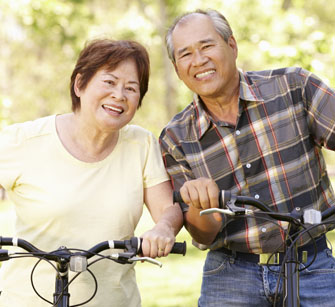Benefits of Physical Activity:
- Increases muscle strength. Studies have showed that muscle strength can be increase from 50-100% by doing physical activity, leading to better function and fewer falls.
- Improves blood circulation. The normal aging process brings decreased blood circulation to organs including the heart, liver, kidney, and brain. Physical activity can combat this part of the aging process.
- Sharpens memory. A recent study showed that the brain’s memory center, the hippocampus, grows bigger with physical activity, which both prevents and treats dementia.
- Improves mood by allowing better sleep and release of endorphins (the happy hormones).
- Increases bone density. Our bone density peaks at age 30, then gradually decreases, especially in women after menopause. Physical activity places pressure on bones and can increase bone density. If you do your activities outside, vitamin D can be produced by your skin from sunshine. Vitamin D helps with the absorption of calcium to make bones stronger.
- Modifies lipids. Decreasing bad cholesterol (LDL and triglycerides) and increasing good cholesterol (HDL) protects against stroke and heart attack.
- Lowers blood sugar and normalizes blood pressure.
- Improves appearance. Physical activity firms the body, trims fat, and can boost metabolism by as much as 15%, which helps with weight control.
- Promotes social opportunities. Exercising with friends or family gives you a chance to visit and chat while you work out.
-
Walking
-
Jogging
-
Swimming
-
Biking
-
Dancing
-
Weight-lifting
-
Golf (walking instead of using the cart)
-
Tennis
-
Yoga
-
Housework, especially sweeping, mopping, vacuuming
-
Yard work, especially mowing and raking
How Much Physical Activity Should I Do?
Start low and go slow. Gradually increase the duration and intensity of your activity to reach a goal of 40 minutes, 4 times a week, and 10 minutes of increased heart rate per session.
What If I Have a Chronic Condition?
If you have a health condition such as arthritis, emphysema, or heart disease, it doesn’t mean you can’t be active. In fact, it’s just the opposite. Regular physical activity can improve your quality of life!
Talk with your doctor to find out if your health condition limits your ability to be active. Then, work with your doctor to come up with a plan that matches your abilities.
What If I Have a Disability?
If you are an older adult with a disability, regular physical activity can provide mental health benefits and improve your ability to do everyday tasks. Seek advice from a professional with experience in physical activity and disabilities. They can tell you more about the amounts and types of physical activity that are appropriate for you.



